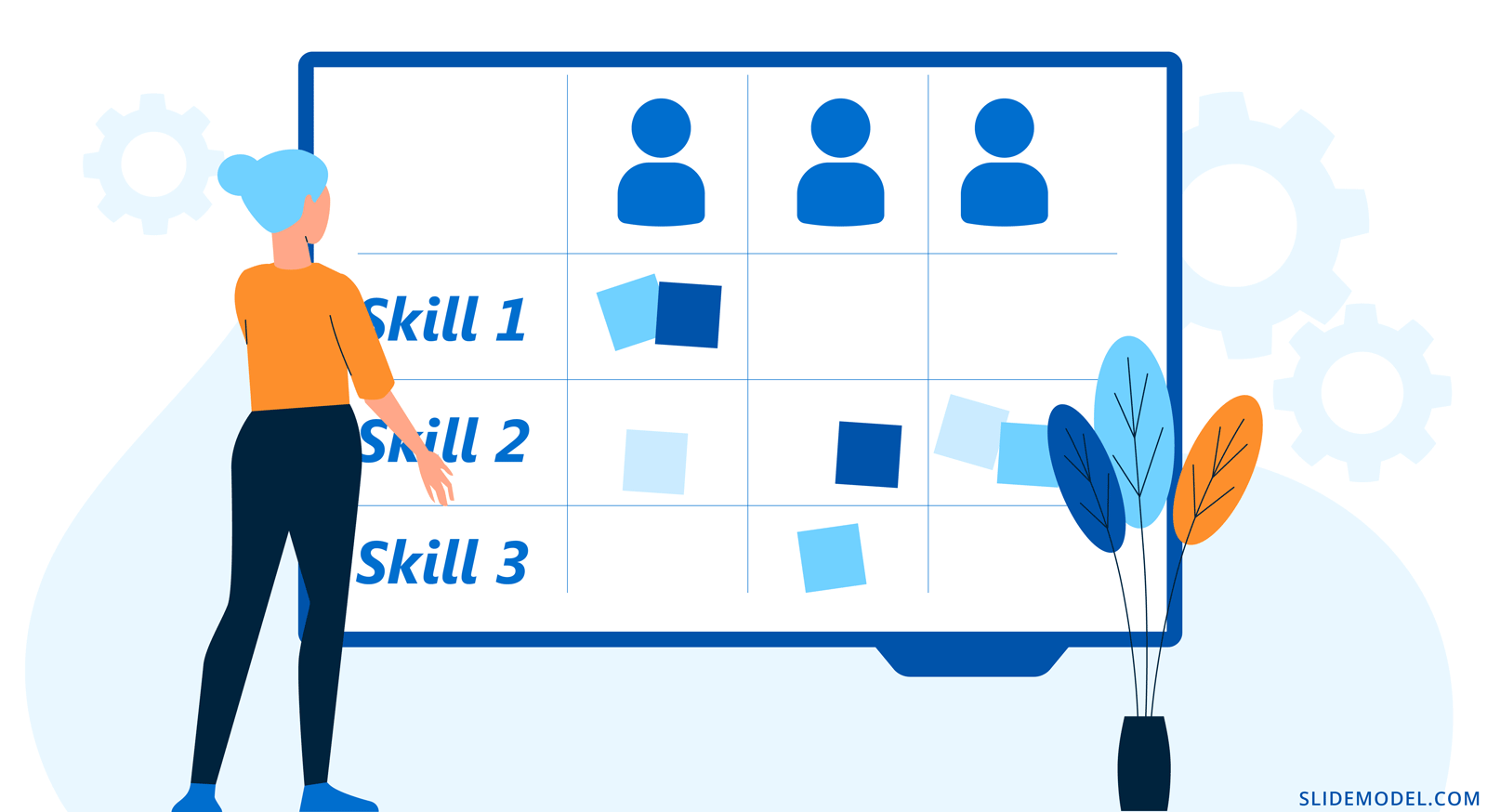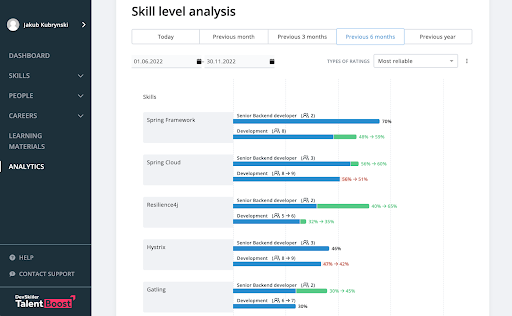What is skills mapping? Meaning and benefits

In today’s competitive job market, this skills mapping exercise has become essential for Human Resource (HR) professionals and Learning & Development (L&D) workers.
Organizations need to have a skilled workforce to stay ahead of the competition.
As such, companies need to understand the existing skills of their employees and identify skill gaps to develop targeted training programs. Skills mapping can help you with this task.
Skills mapping analyzes and identifies employees’ skills to determine their competency levels and recognize skill gaps that need to be filled.
This article will discuss the meaning and benefits of skills mapping, and how it can be implemented in an organization using DevSkiller’s TalentBoost.
What is Skills Mapping?
Skills mapping involves identifying and documenting employees’ technical and soft skills within an organization. The process consists of creating a skills matrix, a spreadsheet, or a visual chart that maps employee skills against the skills relevant to their job or role.
To create a skills matrix, first, organizations must determine which essential skills are necessary for each position. They must assess skills and can use job descriptions or conduct skills assessments to identify these skills.
Next, the skills of the team’s capabilities and members are assessed using self-assessments, assessments by managers or peers, or testing. The results of the evaluations are then entered into the skills matrix.
The skills matrix can identify skill gaps and areas where team members lack the right skills as required for their job or role. Skill gaps can occur due to technological changes, job requirements, or business processes.
Once identified, skill gaps can be addressed through training or hiring to ensure the organization has the necessary top skills needed to achieve business goals.
Why is a skills matrix so important?
A skills or training matrix is essential for organizations, their human resources departments, and their employees. It is a skills mapping process used to identify the various hard skills and soft skills (and missing skills) and competencies required for each role and job function within the organization.
This information can be used to develop targeted training and development programs that can help employees to acquire new skills, identify gaps close skill gaps, and advance in their careers.
To have a clearer picture of your employee’s various skill sets and levels, a skills assessment can be facilitated through TalentScore.
For the organization, a skills and competency matrix also helps optimize its resources by aligning its employees’ skills and competencies with its goals and objectives. This can lead to improved productivity, increased efficiency, and a more competitive advantage in the market. Additionally, it offers a visual representation of where the organization may need to hire new talent or outsource certain functions.

For the HR department, a skills matrix provides valuable insights into the team’s skills and competencies of employees. This information can be used to identify areas where employees may need additional training and development and to develop succession planning programs that can help ensure the continuity of the talent pool within the organization.
This matrix or skills map can help HR departments improve the hiring process as the identified important skills can be used to create job descriptions that accurately reflect these requirements.
For employees, a skills matrix can be a valuable tool for career development. By understanding the particular skills and competencies required for their role and job function and needed skills elsewhere, employees can develop targeted training and development plans to help them acquire new skills and advance in their careers. The result often leads to increased job satisfaction, motivation, engagement, and improved job performance.
Overall, a skills matrix provides valuable insights into the skills and competencies required for each role and job function. It can be used to develop targeted training and development programs to help employees acquire new skills and advance in their careers.

The benefits of skill mapping
There are several benefits to implementing a skills mapping program within an organization:
- Identifying skill gaps: Skill mapping enables organizations to identify areas where team members lack the specific skills to perform their jobs or roles effectively. This information can be used to develop training programs or to hire employees with the required skills, thus improving productivity and reducing errors.
- Creating clear career development plans: Skill mapping gives team members a better chance to understand the essential skills to advance their careers within an organization. Employees can use the skills matrix to identify their current skill level, the skills required for advancement, and the training needed to acquire those skills.
- Improving the hiring process: Skills mapping can help organizations identify the necessary skills for a position and to match candidates’ skills to the job requirements. For organizations, this means a reduction in recruitment costs and time-to-hire while improving the quality of new hires.
- Fostering team member engagement: By identifying skills gaps and providing training and development opportunities, skills mapping programs can improve team member engagement and job satisfaction. Employees are more likely to feel valued and invested in their organization when they have opportunities to learn and develop their skills.

- Better Decision Making: Skills mapping and skills matrices provide HR departments with data-driven insights to help inform decision-making. It enables organizations to make informed decisions about training and development programs, hiring, and resource allocation, leading to better outcomes and increased competitiveness.
- Better Succession Planning: A skills matrix enables organizations to identify potential successors for critical roles. A skills map allows HR departments to develop targeted development programs for employees, preparing them for future leadership roles and ensuring a smooth transition when key personnel retire or leave the organization.
- Efficient Resource Allocation: A skills matrix can help organizations to allocate resources more efficiently. By identifying the skills and competencies of employees, organizations can assign the right person for the right job, improving productivity and reducing the risk of errors.
How to do skills mapping
Let’s take a look at the process of skills mapping as well as the recommended steps.
- Set objectives
First, it’s important to define the objectives for your skills mapping activities clearly. There are a number of reasons why skills data can come in handy. Most of the time, organizations use it to identify skills gaps and devise more effective learning and development campaigns. It also wouldn’t hurt to think of an idea skills score that your employees should possess for each role.
- Prepare skills matrices for different departments/teams
The bigger your organization is, the harder it will be to map your company-wide competencies. This is why it’s highly advisable to take it one step at a time and map skills for every department separately. So make sure you have skills matrices for every department and/or team to have a better overview of your workforce skills.
- Run skills assessments
With all the preparation in place, it’s time to conduct skills assessments. If you don’t have a specialized skills assessment tool at your disposal, you can create and assign tests manually using for example a spreadsheet.
- Collect feedback
To ensure your skills mapping campaign is going smoothly, ask both your employees and managers for feedback. This will allow you to make the necessary adjustments and yield more accurate results.
- Analyse results
Once you have your skills data, you can add it to a spreadsheet for better visualization and start looking for insights.
Skill mapping with DevSkiller’s TalentBoost
DevSkiller’s TalentBoost is a skills management software tool that can help organizations to transition to a skills-based approach to talent development. Have you ever needed to fill a skills gap?

TalentBoost gives users a 360 view of your employee’s digital skills to unleash their full potential. Skills mapping has never been made easier. Some of the possibilities with Talentboost include:
- Discover and close skills gaps with ease
- Identify priority areas to reskill and upskill employees with in-demand skills.
- Enable systematic feedback & development conversations
- Keep your employees happy and engaged by supporting their professional development.
- Increase retention rate, morale, and productivity. Here are some of the ways TalentBoost can help organizations to manage skills more effectively:
- Transitioning to a skills-based organization: TalentBoost helps to align digital skills needs with company goals to maximize performance. TalentBoost makes skills matrices a cinch, offering you a complete understanding of the skills for each role or position within the company. Using this software, you can identify employees with prerequisite skills to make quick progressions.

- Easy skills management: You must no longer bury skills data in overcomplicated spreadsheets. TalentBoost allows users to visualize and act on talent insights at the right moment. The platform enables managers to track and analyze employee skills and quickly identify skill gaps. Team members can also update their skills profiles, providing a real-time view of skills across the organization. With TalentBoost, you’re able to offer impartial employee evaluations and increase morale through fair and transparent management practices.
- Clear skills-development plans: Keep your employees happy and engaged by supporting their professional development. TalentBoost enables managers and team members to create clear skill-development goals. These plans can include online training courses, and in-house training programs, to develop and acquire those skills. Increase retention rate, morale, and productivity.
DevSkiller allows you to merge and compare data from TalentScore and TalentBoost for more detailed profiles of your staff by integrating the DevSkiller software suite. Realize the untapped potential of your workforce by mapping and developing your digital skills to achieve your business goals.
Final words
In conclusion, skills mapping is crucial for HR practitioners and L&D professionals to manage employees’ skills and address skill gaps. The benefits of skill mapping include improved employee performance, better talent retention, employee learning, enhanced workforce planning, and improved decision-making.
With skill mapping, HR practitioners can also quickly assess the skill level of team members and identify areas for improvement. Furthermore, it is skill map that facilitates the identification of technical skills and competencies required for specific job roles.
By creating a detailed inventory of employees’ hard and soft skills, we can identify skill strengths and weaknesses. This knowledge then guides training and development efforts for existing employees and informs the hiring process, resulting in a more efficient and productive team.
To create a more robust hiring strategy, DevSkiller’s TalentBoost provides an excellent platform for skill mapping, enabling organizations to transition to a skills-based approach and manage skills efficiently. Skill mapping with TalentBoost is an effective way to make talent development plans build a competent and skilled workforce, improve employee engagement, and drive business success.
Source: Tashatuvango / Shutterstock
Share post